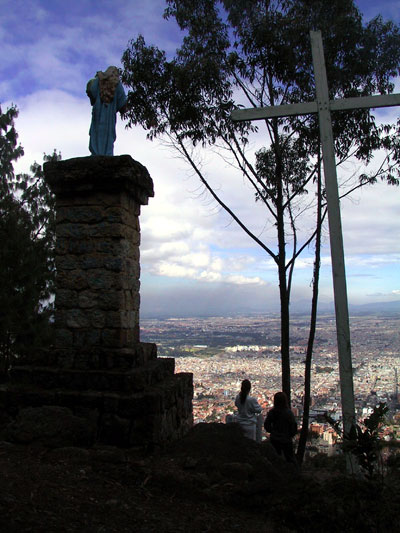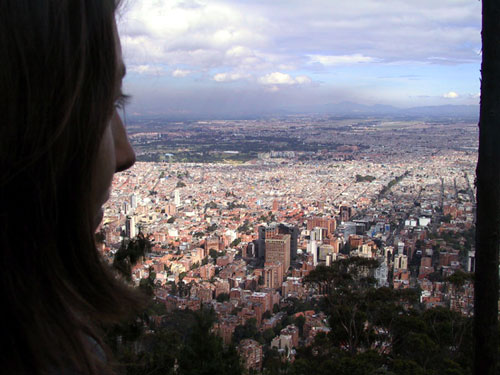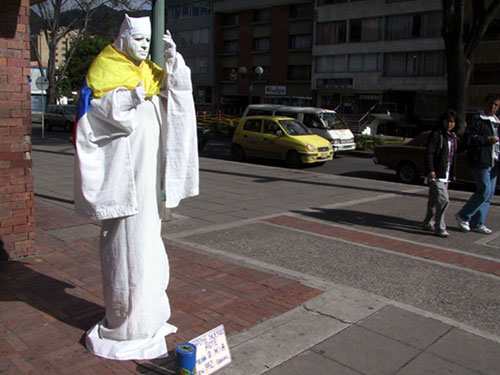
We are walking a rugged dirt trail up a steep forested mountain at 8,500 feet. With my sea-level lungs, I lag behind the group as my girlfriend, Anamaria, her father, and several friends jaunt ahead up the hill. Hoping that months at Bogotá’s altitude have acclimatized me a bit, I muster my energy and try to catch up with the rest.
“Hey!” I say in my best breathless Spanish.
The group pauses as I come up the path, and Anamaria’s father, Luis Alfonso, flashes his mischievous, toothy grin.
“Wait for the Gringo!” I gasp.
Before he can tease me with one of his trademark jokes, we are interrupted by the crack of a rifle shot.
The sound echoes and rumbles as we doubtfully consider the forest around us. The unstated question hangs in the air: Should we abandon our Sunday morning walk and head back down to the city? I’ve heard that there is a group of soldiers nearby, but I’m not reassured. Luis Alfonso scratches his chin. “If the army is shooting at things, that’s a sign of order. Let’s keep on going!” And off he goes, followed happily by Anamaria and our friends.
I can’t help but laugh. Gunshots are no more common in my experience of Bogotá than they were in the United States. But something tells me that interpreting gunshots as a sign of order and security is a distinctly Colombian behavior. It’s hard to decide if it constitutes denial or simply a kind of psychic self-preservation, but for some reason I’m completely happy to continue up the mountain, savoring the anticipation of a majestic view.

Clear and present paranoia
It can safely be said that Colombia holds a certain horror for people from the United States, if not the whole world. Non-Colombians can hardly be blamed for the negative impression, considering the information they get. One need look no further than Hollywood, which has produced such informative travelogues such as Collateral Damage (Schwarzenegger battles Colombian terrorists), XXX (Vin Diesel spends a scene or two battling Colombian guerillas), and Clear and Present Danger (Harrison Ford battles Colombian narcoterrorists). The world-famous Colombian drug trafficker Pablo Escobar, although dead 10 years, also left us a rich legacy of imagery with which to envision Colombia: the corpses of politicians, judges, and journalists gunned down in the streets by $20 assassins, car bombs exploding right and left in Bogotá, half the government on the take and the other half brought to its knees by the power and caprice of a single criminal megalomaniac.
And that’s even without mentioning the 40-year-old civil conflict (or is it 60 years old? One hundred?), in which a tangle of leftist guerillas, right-wing paramilitaries, and government forces fight among themselves, killing and displacing thousands of civilians every year. Funded in large part by the appetite for cocaine in the United States and Europe, this once-revolutionary struggle has long since been drained of its ideology, and seems doomed to continue pointlessly for all time.
For this reason, Colombia (or “Columbia,” as it is often misspelled in the United States) is irresistible to foreign news media, who can count on the country’s “widespread violence” or “war-torn” nature to excite the audience. (Covering all bases, NPR host Tavis Smiley once even concluded a segment on the country with the phrase “war-, drug-, and assassin-torn Colombia.”) If the media isn’t hair-raising enough, one can read the State Department’s online travel advisory: the deceptively dispassionate tone puts a special shine on terms such as “extremely violent” and “risky.”
So it was difficult for me not to worry a reasonable amount in the weeks leading up to my move south to live with Anamaria. Even the most uninformed acquaintances, upon learning of my plans, would in solemn voices offer counsel along the lines of, “Whoa, man. Be careful down there.” It didn’t help when I emailed a journalist friend in Bogotá to ask for his perspective on safety in Colombia. In his reply, he reflected, “Well, I have been kidnapped, shot at (too many times to count), and nearly blown up by a car bomb, motorcycle bomb, and another smaller bomb. So, take that into consideration.” I was unclear how I could take his advice “into consideration” and still go, so I decided to ignore it. After all, I was moving to South America for love, and a little bit of danger just made buying the ticket more exciting.
Once the plane landed in Bogotá, though, my mind began to fizz with paranoia. I actually laughed out loud at myself but was unable to quell the rising tide of dark fantasies. What were my chances of getting kidnapped? And the friendly passengers around me … surely they were drug mules returning from New York? I found it hard to believe that I had somehow actually ended up in this country, which I surely would never have visited were it not for my unfortunate love for one of its citizens.

The charms of a Third World kaleidoscope
But after nine months in Bogotá, I am yet unkidnapped. My fears having gone unrealized, I am now a vocal proponent of the city. It’s a wonderful place. The same goes for Cartagena, for Montería and the Caribbean coast, and (from what I hear) even for Medellín, former home of the legendary Pablo Escobar. It turns out that large tracts of this country simply fail to live up to the Colombian rep.
Bogotá, for one thing, is an exciting, diverse, cosmopolitan, challenging city, a metropolis of 8 million, steadily sprawling across its high mountain plateau. It is less a cauldron of Latin American violence than a bewildering mix of contrasts. From the luxurious gated communities in the northern areas of the city, you can drive 40 minutes south to find poor barrios with mud streets and shacks made of corrugated tin.
The very streets reflect the spectrum defined by those two poles. Roads are shared by late-model luxury sedans and sport utility vehicles, tiny two-door economy cars, taxis both shining and crumbling, a swarm of mopeds and motorcycles, the occasional horse cart, and the pushcarts of “recyclers,” piled with cardboard and scrap metal. There is also a multitude of privately owned buses that screech to a stop any time pedestrians hail them. Musicians and street performers continually ply the buses and intersections. On any given bus ride, you may be treated (or subjected) to people playing guitars, pan pipes, drums, even full-size harps, or hawking candies, peanuts, pens and pencils, books, maps, or any other item that can be carried on to a bus. At intersections, jugglers, stilt-walkers, fire-eaters, and beggars of all ages perform and plead before cars stopped at traffic lights.
It was only a day or two before the last of my misconceptions evaporated, leaving only delight at this urban kaleidoscope. And the diversity goes beyond the experience of the streets. Colombia is a nation obsessed with its regional styles of music, food, and climate. To turn on the radio or choose a dance club is always to find something different: the accordion-laced laments of Vallenato, the ever-present Salsa, Rock en Español (Spanish rock), the stomping cowboy dance songs from the eastern plains, the African rhythms of the coastal north and west, and every kind of imported pop, hip hop, rock, and reggae.
There is a lot more growing in Colombia than cocaine. The country is, acre for acre, the most biodiverse nation on the planet, heir to a lush collection of distinct ecosystems and their unique flora and fauna. I can’t even visit the supermarket without lingering in the produce section, fascinated by stacks of bizarre fruits with a dizzying array of names and tastes: feijoia (something like a prehistoric kiwi), guanabana (tastes like coconut crossed with pineapple, looks like a spiky, green football), curuba (indescribable), granadilla, tomate de arbol, nispero, zapote … each of which is almost as unexotic here as an apple or a watermelon in the United States. These specimens are accompanied by great quantities of limes, mangoes, passionfruit, cantaloupes, bananas, and so on. You can order four or five of these fruits as fresh juice (made on the spot) in any halfway decent restaurant, confirming Colombia as the world’s most advanced civilization in terms of juice. A lack of fresh feijoa or guanabana juice in a restaurant is almost enough to make diners walk out.
The good life
So life is evidently very good here. But at a certain point, I started to wonder at the disconnect between the quality of life I was experiencing and the undeniable problems facing the country. I found that a few minutes skimming the newspaper headlines were enough to keep me more up to date on Colombia’s problems than most of my Colombian friends. For instance, on the night of the FARC (Revolutionary Armed Forces of Colombia) guerillas’ 40th anniversary, the police intercepted a one-ton truck bomb intended to destroy a long tunnel beneath the mountains southeast of Bogotá. It was the kind of news that in the United States would have produced days of screaming headlines. But I have Colombian friends who have never heard of the incident, and are happy to leave it that way.
I don’t question their attitude openly. This is partly because it seems impolite for a foreigner to rub a country’s troubles in the face of its people. I also don’t want to be seen as the paranoid gringo. An American who is even minimally preoccupied with safety and security in Colombia may never escape the stereotype of his countrymen: lots of money, lots of fear, and little common sense. It is a stereotype reinforced by the U.S. embassy here, which warns its citizens not to frequent the popular restaurant and club areas of north Bogotá, for fear of the guerilla bombings that are surely to come.
Accordingly, I avoid harping on the subjects of war, drugs, or terror in Colombia. And this is easy to do, since Colombia’s narcoterrorists, guerillas, and cheap assassins are conspicuously absent from my daily life. Thus I participate in a kind of collective denial about violence and injustice here.
The evidence is there for those who want to see it. Families displaced by violence in the countryside beg at car windows in the streets of north Bogotá. And there are obvious and overwhelming differences in wealth and skin color between the powerful and the powerless in Colombia. While it may take a few society dinners to notice that many of the elite here are as white-skinned (if not as fair-haired) as any gringo, a single afternoon’s drive through downtown Bogotá is enough to see that strongly indigenous or African features correspond tightly to economic and social disadvantage. Even discounting racial factors, Colombia is deeply classist: breathtaking economic inequality is a hallmark of the country’s history, politics, and daily life. It almost makes you admit that the guerillas might have had a point when they started their rebellion.
Blissful denial
Although Colombia’s reputation in the world is certainly undeserved, there are also plenty of unsavory things most Colombians just don’t want to think about. On the inside walls of buses, which are decorated according to the driver’s idiosyncratic tastes, I have seen decals that read, “Here we don’t talk about the situation. Here we’re good, and getting better!” Perhaps this forced optimism is what happens after 40 years of intractable conflict. Perhaps it’s just pride.
Either way, it’s more than a facile attitude confined to the living rooms of posh Bogotá high-rises. Even taxi drivers complain about Colombia’s unfair reputation, and then rhapsodize about the fruit, the music, and the women. Denial here is not so much a deliberate self-deception as it is an expression of patriotism and a determination to enjoy life. In Colombia, I have learned that even a society fraught with social injustice and protracted civil war can for some be an excellent place to live. And Colombians are a people determined to exploit this fact to its fullest.
In spite of this pervasive positive spirit, however, it would be untrue to say nobody in Bogotá ever worries. Especially among the upper classes, fear expresses itself in the rituals of everyday life: 24-hour doormen who sit behind presumably bulletproof glass. Security personnel who peek into the purses and backpacks of shoppers entering upscale malls. Bomb-sniffing dogs at the entrance of underground parking garages. The mundane sight of military police armed with machine guns standing outside “important” residences. Most of all, fear generates myths and rumors. People in northern Bogotá are afraid of the southern side of their own city. The barrio known as Ciudad Bolívar, for instance, occupies a similar place in the imagination of Bogotá’s citizens as Colombia does in the minds of North Americans: an almost legendary place full of criminals and violence, which only a fool would enter. This might merely be urban folklore, told to frighten Colombian children. But in the case of Ciudad Bolívar, at least, I’m not interested in finding out.
Closer to home, the local variety of fear is usually once-removed. Rumors often circulate about friends-of-friends who have been robbed or attacked. (In the absence of an immediate guerilla threat here in Bogotá, common crime is the main stimulus for worry.) The hillside behind our well-off northern barrio of Rosales in particular draws local concern. A verdant forest crowned with spectacular ridges, its steep paths offer a perfect opportunity to exercise and escape the pollution of the city below. But mention that you enjoy this hill, and you will invariably hear stories about those who have been robbed, raped, or even killed on the mountain. For this reason, everyone agrees, you should only walk there “when it’s safe,” which tends to mean weekend mornings. Presumably that’s when the bad people sleep.
The potential dangers of mountainside walks have been the source of some tension in my pan-American romance, but I’m often reminded that it’s mainly my problem. Anamaria and her father, though deeply good-natured, are that stripe of defiant Bogotanians who consider any change of behavior on the grounds of safety a sign of paranoia and weakness. My repeated suggestions, for instance, that we at least stick together in a group while on the mountain, are often met with rolling eyes and the implication that this is tantamount to staying home and hiding in the closet. And although everyone agrees that we should hike the mountain “only when it’s safe,” this rarely translates into any actual change in behavior. After all, that would be giving in to fear.
To a certain degree, I’ve begun to adopt this attitude myself. If my options are either to be branded a scared gringo or simply to enjoy all that Bogotá and its people have to offer, I choose the latter. This is why, when Anamaria’s father creatively interprets the sound of a gunshot as a sign of safety and security, I’m pretty much content to continue up the mountain.
At the top, the path splits in several directions, and we follow it to the left along a pine-forested ridge that opens onto a lush gully to the right. Scrambling up some rocks, we arrive at our destination, hundreds of feet above the city. The ridge ends in a large knobby outcropping, topped by a small plateau from which we can see almost everything. A giant cross and a statue of the Virgin Mary stand here, gazing out over the unbelievable view: The Andean plateau of Bogotá stretches away to the distance, blanketed everywhere with buildings and roads, humming with the lives of 8 million people. For a moment, I can’t quite remember why everyone is so scared of Colombia.
STORY INDEX
TOPICS > COLOMBIA
Center for International Policy’s Colombia Program
URL: http://www.ciponline.org/colombia/index.htmReVista (Harvard Review of Latin America) issue on Colombia
URL: http://drclas.fas.harvard.edu/publications/revista/colombia/tcontents.htmlEl Tiempo (Colombian national newspaper — in Spanish)
URL: http://www.eltiempo.com.coSemana (Colombian national magazine — in Spanish)
URL: http://www.semana.com.co
- Follow us on Twitter: @inthefray
- Comment on stories or like us on Facebook
- Subscribe to our free email newsletter
- Send us your writing, photography, or artwork
- Republish our Creative Commons-licensed content

